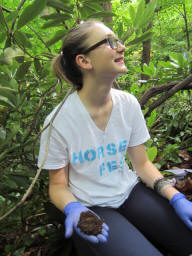Introduction
|
Ferric Iron (Fe+3) is an invaluable inorganic mineral found in soil. Many microbes, plants, and invertebrates use ferric iron to carry out necessary biological functions. Among them is mold. Mold utilizes ferric iron in its mitochondria to aid in growth and reproduction. When soil molds do not have access to adequate ferric iron their levels begin to decline because of an inability to reproduce. Mold is important in soil health because it decomposes dead matter, and returns nutrients to the soil. Bacteria also break down organic matter and return nutrients to the soil, but mold far surpasses bacteria in its decomposing capabilities. Iron is essential for both mold and bacteria because it aids in their ability to grow (iron helps both mold and bacteria to create energy to grow and reproduce).
But what could be causing the lack
of ferric iron in the soil? Bacteria also use ferric iron in a process
that reduces the ferric iron to ferrous iron (Fe+2), a form of iron that
is useless to molds, causing mold levels in the soil to decline. This is
detrimental to soil health because dead matter builds up and there is a
lack of nutrients in the soil.
Following the completion of the Biota survey on the ESSRE Site 4, we noticed that there were very low levels of mold. This was extremely surprising because, as you may know, mold thrives in wet, warm climates, and Site 4 is the only Site that has a stream. When examining the data of all the ESSRE Sites we noticed a trend showing that sites with low mold also had low levels of Ferric iron. After some research we learned that iron is very important in mold reproduction and growth. We then hypothesized that the low iron in site 4 is causing the low mold count and thought that we would design our experiment around mold and iron.
|
|
But, with further research, we stumbled upon an article
about iron and bacteria. It had |
 |